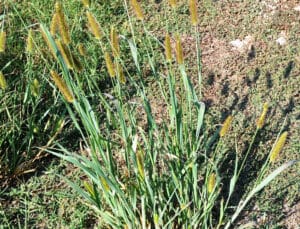Description
Common groundsel is a ubiquitous winter annual broadleaf, but can grow all year in coastal areas of California. It inhabits agricultural land and other disturbed places. Except for deserts, common groundsel is found throughout. Infestations are most problematic during cool, moist periods. Plants die during extended hot and dry periods. Common groundsel contains toxic compounds called pyrrolizidine alkaloids. When ingested in large quantity, or even in small amounts over several weeks or months, they are toxic to humans and livestock. However, livestock losses caused by feeding on common groundsel are uncommon and most poisonings are due to ingestion of contaminated hay or hay cubes over a period of time.
Life Cycle
Fields, vegetable and agronomic croplands, gardens, nurseries, orchards, vineyards, landscaped areas and yards, roadsides and other disturbed, unmanaged places.
Seedling
Cotyelons (seed leaves) are narrowly football shaped to oblong, 1/10 to 2/5 of an inch (3–11 mm) long, with a rounded to somewhat pointed tip, a tapered base, and often purplish below. The first leaves are egg shaped, have edges with shallow teeth, are alternate to one another along the stem, and are about 3/10 to 1/2 of an inch (8–12 mm) long. Third and fourth leaves are more deeply lobed.
Young plant
Young plants remain as rosettes until maturity.
Mature plant
Mature common groundsel stems are more-or-less erect and the plant grows a single stem or branches from the base. It can grow up to 2 feet (60 cm) tall. Leaves are highly variable: they are hairless to lightly covered with long wavy or cotton-like hairs; upper leaves are smaller than lower leaves and attach directly to the stem (without stalks); lower leaves have short stalks. In general, leaves are deeply lobed with toothed edges and evenly spaced on the stems.
Flowers
Flowers bloom nearly year-round. Single, tiny, yellow flowers cluster into non-showy flower heads at the tip of the flowering stem. Green reduced leaflike structures (bracts) with conspicuous black tips hug the base of the flower head, distinguishing groundsel from others in the thistle family. The flower head eventually matures into a white puffball a seed head similar to a dandelion seed head.
Fruits
Fruits are tiny, less than 1/10 of an inch (2.5 mm), cylindrical with shallow ribs, light brown, often hairy, and end in a tuft of delicate white hairs that are eventually shed.
Seeds
One seed is contained in each tiny fruit.





